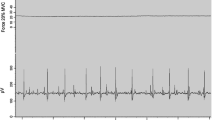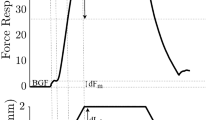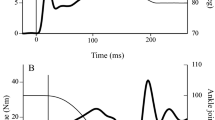Abstract
The aim of this study was the analysis of neurophysiological, mechanical and histochemical parameters to demonstrate muscle adaptation with training. If the parameters studied were to show correlated changes, it would be possible to propose that the neural and the muscle components of motor units are both affected by the training programme used. The training consisted of repeated stretch-shortening cycles known to use extensively fast fibres. After the training period electromyographical reflex activities of the ankle plantar-flexors were recorded in awake rats and then mechanical and histochemical measurements were made on isolated soleus muscles of the control and trained rats. The reflexes studied were the H-response to electrical stimulation of the sciatic nerve and the T-response to an Achilles tendon tap. The H-response analysis indicated a decrease in reflex excitability of the trained muscles. The trained soleus muscle also presented a higher contractility as demonstrated by significantly smaller twitch contraction times and higher maximal velocities of shortening measured during tetanic contractions. The reflex and contractile muscle changes were accompanied by relative increases in the number of type II fibres. The T-response was not significantly modified by training despite the decrease in motoneuron excitability demonstrated by the decrease in H-response. This would suggest that the peripheral components of the reflex pathway such as tendon stiffness and/or spindle sensitivity might be modified by training. This would imply that both the motor and the sensory parts of a muscle are affected by training.
Similar content being viewed by others
References
Almeida-Silveira MI, Pérot C, Goubel F (1994) Effects of stretchshortening cycle training on mechanical properties and fibre type transition in the rat soleus muscle. Pflügers Arch 427:289–294
Bosco C, Ito A, Komi PV, Luhtanen P, Rahkila P, Rusko H, Viitalaso JT (1982) Neuromuscular function and mechanical efficiency of human leg extensor muscles during jumping exercises. Acta Physiol Scand 114:543–550
Brooke MH, Kaiser KK (1970) Muscle fibre type: how many and what kind? Arch Neurol 23:369–379
Casabona A, Polizzi MC, Perciavalle V (1990) Differences in Hreflex between athletes trained for explosive contractions and non-trained subjects. Eur J Appl Physiol 61:26–32
Cochran WG (1964) Approximate significance levels of the BehrensFisher test. Biometrics 20:191–195
Ginet J, Guilheneuc P, Prévot M, Vecchierini-Blineau F (1975) Etude comparative du recrutement de la réponse réflexe monosynaptique du soléaire (reflexe H) chez des sujets non entraînés et chez des sportifs. Med Sport 49:55–64
Hill AV (1938) The heat of shortening and dynamic constants of the muscle. Proc Roy Soc B 126:136–195
Lensel-Corbeil G, Goubel F (1989) Series elasticity in frog sartorius muscle during release and stretch. Arch Int Physiol Biochim 97:499–509
Nardone A, Romano C, Schieppati M (1989) Selective recruitment of high threshold human motor units during voluntary isotonic lengthening of active muscles. J Physiol (Lond) 409:451–471
Nielsen J, Crone C, Hultborn H (1993) H-reflex are smaller in dancers from The Royal Danish Ballet than in well-trained athletes. Eur J Appl Physiol 66:16–121
Pérot C, Almeida-Silveira MI (1994) The human H and T reflex methodologies applied to the rat. J Neurosci Methods 51:71–76
Pérot C, Goubel F, Mora I (1991) Quantification of T- and Hresponses before and after a period of endurance training. Eur J Appl Physiol 63:368–375
Pousson M, Pérot C, Goubel F (1991) Stiffness changes and fibre type transitions in rat soleus muscle produced by jumping training. Pflügers Arch 419:127–130
Rack PMH, Ross HF, Thilmann AF, Walters DKW (1983) Reflex responses at the human ankle: the importance of tendon compliance. J Physiol (Lond) 344:503–524
Schmidtbleicher D, Gollhofer A (1982) Neuromuskuläre Untersuchungen zur Bestimmung individueller Belastungsgrößen für ein Tiefsprungtraining. Leistungssport 12:298–307
Türker KS, Miles TS (1990) Cross-talk from other muscles can contaminate EMG signals in reflex studies of the human leg. Neurosci Lett 111:164–169
Wilt F (1976) Plyometrics. Track Technique 63:1962–2022
Woo SLY, Ritter MA, Amiel D, Sanders TM, Gomez MA, Kuei SC, Garfin SR, Akeson WH (1980). The biomechanical and biochemical properties of swine tendons — long term effects of exercise on the digital extensor. Connect Tissue Res 7:177–183
Yoshimura A, Fujitsuka C, Kavakami K, Ozawa N, Gala H, Fujitsuka N (1992) Novel myosin isoform in nuclear chain fibres of rat muscle spindles produced in response to endurance swimming. J Appl Physiol 75:1925–1931
Author information
Authors and Affiliations
Rights and permissions
About this article
Cite this article
Almeida-Silveira, MI., Pérot, C. & Goubel, F. Neuromuscular adaptations in rats trained by muscle stretch-shortening. Europ. J. Appl. Physiol. 72, 261–266 (1996). https://doi.org/10.1007/BF00838649
Accepted:
Issue Date:
DOI: https://doi.org/10.1007/BF00838649




